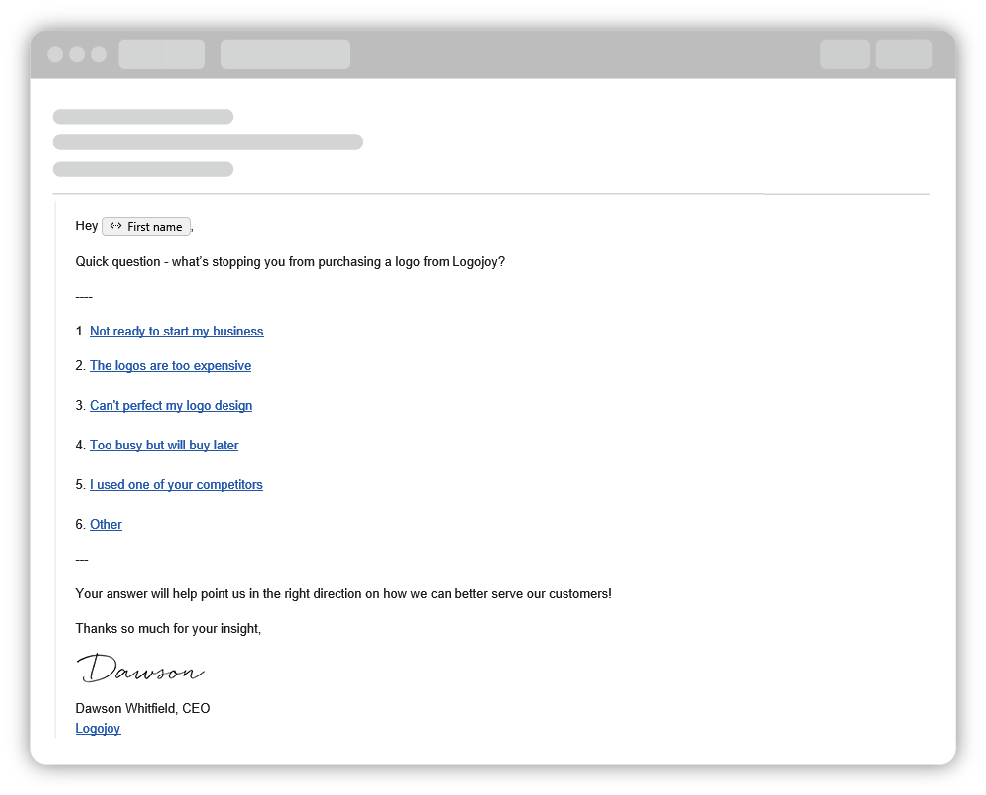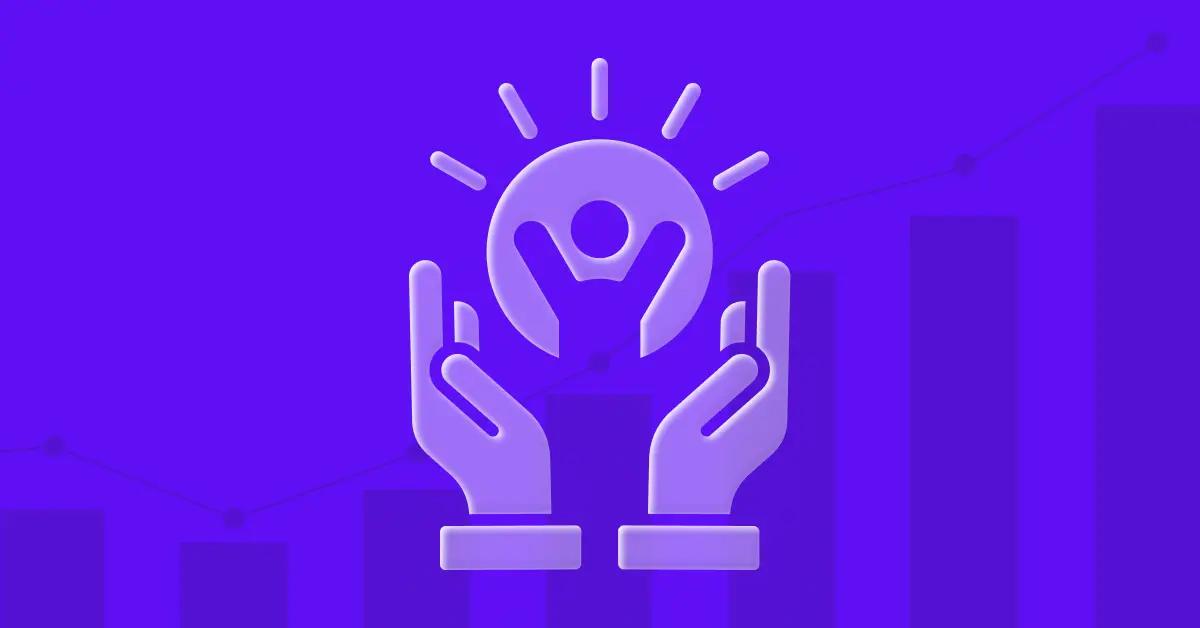'Customer feedback is important', 'Companies that listen to their customers grow 10x faster' or 'You can't afford to ignore customer feedback'- I'm pretty sure you heard such phrases many times.
Customer feedback is powerful information that can give you crucial insights into every part of your company helping you make more money or cut marketing expenses.
That’s especially important when it comes to customer satisfaction. In this guide, you will learn all about customer feedback. I will guide you through the following key points specifically:
- What is customer feedback?
- Why is customer feedback important?
- What are the benefits of customer feedback?
- How does customer feedback help with marketing goals?
- How to get customer feedback the right way?
- What are the best practices of collecting customer feedback?
- How to improve Google remarketing with customer feedback?
Ready to start running a customer feedback survey right away? Start your free trial with Survicate, and you'll get access to all Best plan features for 10 days. Also, you can foster your decision by checking our newest ranking of best customer satisfaction tools.

What is Customer Feedback?
Customer feedback is information given from your customers about the quality of your product, customer service or any processes or transactions at your company. It's all about meeting customer requirements.
In fact, there is no better and more reliable source of knowledge about your company than customer feedback.
Customer feedback can be acquired with customer surveys such as the NPS survey. Play with it - it's interactive (and free to run)
Why is Customer Feedback Important?
1. It points out aspects of your product that need improvement
You know your product or products by heart. Every product feature or application you implemented was well researched and widely discussed by you and your team thousands times before the implementation.
At the same time, this can be the reason why you might not see the imperfections.
It is important to discover what suits your customers best - what they enjoy about your products, what they dislike and understand why. Showing that you truly listen and praise customer voice will eventually let you succeed in business (better than anything else!).
After all, your product is made for customers, so it should be as close to what they desire as possible.
By the way, this free product feedback survey template will help you gather customer feedback in minutes. See how it works and use it right away!
2. Listening to customer feedback makes customers feel involved and important
Nothing proves your customers that they are important better than asking questions and acting on it accordingly.
When asked for in-app feedback about product, website experience or any other interaction, your customers feel valued and treated almost like a part of your creative team. By asking for customers feedback you make them feel their opinions truly valued.
When the customers feel listened to, they begin to have positive connotations with your brand and direct their good experience back at you, which in turn could lead to more sales in the future.
One caveat: You must actually act on collected feedback when making product features choices. It's necessary to implement customer feedback and then once you deliver the desired improvements – communicate the good news to the customers who requested them, otherwise, they will feel neglected.
This process is called - customer feedback loop - the advanced strategy for constant product improvement based on customer feedback and suggestions.
3. Good customer feedback generates positive reviews
Word of mouth advertising is still the most successful acquisition channel, especially for inbound marketing where the customer comes to you, not the other way around.
Referrals are the most effective and at the same time free way of advertising. The study conducted by Kellerfay for the RewardStream, revealed that
personal recommendations are the top motivation for purchase decisions, not just while finalizing the sale, but at every step of the purchase cycle.
This was true for ten different areas of trade, such as, for instance, traveling, banking and apparel. While other factors that influence customer’s decision like advertising or price comparison websites influence their decision only at one stage of decision making, recommendations were extremely important throughout the purchase process.
According to the author
‘Over 8-in-10 purchases influenced by a recommendation are influenced by people talking face-to-face.’
That means that on average, only 20% of people who turn to your company because of a recommendation, will do so due to what they have read on social media.
Word of mouth = personal recommendations usually come from trusted sources such as close friends or family. This makes word of mouth even more reliable than positive reviews shared by subject matter experts.
If you want to gain customers through positive reviews and word of mouth, make sure that customer feedback you get is positive.
4. Customer feedback helps to convince them to come back for more
Every online store can sell a lousy product to a given person once. But it's not the way to scale businesses.
One-off sale won't guarantee the customer will come back to for more.
While you can keep perfecting all the aspects of your online presence, such as product quality, pricing, website, content and advertising just by observing the competition and the market, there are aspects only honest customer feedback will reveal.
Feedback may reflect the factors that you did not take into account before, such as free shipping, safe packing, polite and available customer service consultants, user-friendly website. Although at first, you might not get just positive reviews, that unique customer insight will help you understand the concept of customer’s desired approach and result in happy, repeat customers.
5. Negative customer feedback is good for you!
When the competition is just two clicks away, it is vital to tackle any issues reported by your customers immediately.
Unhappy customers who provide feedback should be seen as an opportunity.
They could just write negative online reviews on your social media channels, or even worse, leave an anonymous comment on a forum.
Instead, they took the effort to contact you and share their customer experiences, trusting that you can fix it.
Negative customer feedback should be valued even more than any other because it gives you the winning growth strategy on a silver plate!
For this reason, create an action plan to tackle the unsatisfied customers’ feedback first. It should look like this:
- Contact the customer
- Address the issue
- Provide the ETA (estimated time of arrival) when the issue can be fixed
- Inform when you will contact them again
- if the issue is more complex, then make sure that you compensate them for the poor experience.
Without a plan, things can go badly, so better don't leave negative customer feedback with no response.
You do not necessarily have to give customers a free product, but even a 5% discount at your online store will make this overall difficult experience, look a bit better for the customer.
Chances are, the new client will give you another shot and a regular customer will treat it as a small mistake that should be forgotten.
Learn more about how to respond to negative feedback based on real examples.
6. Customer feedback helps you acquire new customers
What is the first thing you do when you look up a company whose product you’d like to buy? Likely you check the company reviews. As we already mentioned, personal recommendations are more effective than online reviews, however, that doesn’t mean that the latter should be underestimated.
According to data collected by Invesp,
90% of customers read online reviews before visiting a business website and 88% of customers trust these opinions almost as if they were personal recommendations.
If you care about the quality of the online reviews, better keep your finger on the pulse. So better ask for customer feedback and act on it regularly.
7. Listening to customer feedback helps you build loyalty for the brand
Actively asking for feedback from clients using customer feedback software and responding to their opinions create a sort of relationship that makes the purchase process more personal.
The customers begin to perceive your company as a business created by friendly people who truly care about their experience.
Maintaining relationships with clients pays off. Instead of being just a company who sells quality products, you become their favorite company.
The Benefits of Customer Feedback
1. Improve your website
Improving website design is often the first step to use customer feedback. A solid website is incredibly important for almost any company. It’s easy to translate customer feedback into changes that boost the company’s revenue. If people don’t like your website they don’t want to do business with you.
And we’re talking not only about colors - navigation, layout, searchability, and responsiveness are among crucial factors that affect people’s perception of your website.
This website design feedback survey template can help you start! Try it free.
Even if you test your website you can’t be 100% sure it looks and works well on all devices and browsers at all times. That’s why it’s worth researching how visitors assess your website.
It’s especially important when you redesign your website. It can turn out that visitors don’t really like the ideas of your designer and prefer the old version or have great ideas about what to change.Here’s example of such finding by one of Survicate’s customers: Nationale Nederlanden Investment Partners.
They discovered that a redesign was a mistake and implemented a new design shortly. It was much better than the previous one.
Another way to improve the website and increase conversion rates, important for e-commerce, is making the purchase path as seamless as possible. You’re likely to see that even more than 70% of potential customers abandon carts. So ask them why they are doing it.
Their answers will help you improve the checkout process and increase conversion rates and revenue quickly. Website exit surveys are the best for that, you can learn more about them in our guide to website exit surveys.
2. Tailor the offer to needs of customers

Offering what people need is one of the keys to a successful business. It applies to all kinds of businesses, from e-commerce to services to SaaS. For e-commerce, it’s a matter of inventory.
For services - a range of services. For SaaS - features of products and possible additional services. Building new features or expanding inventory without taking into account customers’ needs is risky.
That’s why you should ask your existing and potential customers what products, services, or features they need. You can learn that they need something you would never think of, like in this example of our customer. RaveNectar, a shop selling artistic t-shirts, found out that what people want is not eg. hoodies or tanks but yoga mats and leggings. Go figure.
3. Improve customer satisfaction
Who agrees with me that acquiring new customers is expensive? I bet many of you. We need to invest in PPC campaigns, social media, sometimes offline advertising or trade shows, etc. Not to even count costs like developing and maintaining a great website.
But here’s something to cheer you up. According to stats, a loyal customer is worth even up to 10 times more than their first order due to returning orders and referrals. That’s why we should make sure that customers stick with us. For that to happen, we need to know how satisfied they are and what we can do to make them love us.
That’s exactly what Net Promoter Score has been created for. Ask your customers how likely they are to recommend you and what are the reasons for their answers. Sometimes, even a few answers can show you what you should improve to increase customer loyalty or what works well already and is worth highlighting. Increasing customer satisfaction scores will allow you to spend more on customer acquisition and speed up the growth of your company.
Learn more about extremely important customer satisfaction metric Net Promoter Score.
4. Understand how customers find you
Web analytics changed the way marketers work. We don’t have to guess anymore how people find our websites and what they do once they reach them. But wait a minute - there’s ‘direct’ traffic.
People coming from different sources land there and sometimes it can be a big chunk of total traffic (30% is normal, although watch for spam). Plus, people googling for your brand somehow know it, right? How to learn how people end up on your website? Just ask them.
It’s important especially if you invest in offline campaigns promoting your brand or website - the results of this survey will show you how effective those campaigns are. Invest more in channels that bring you customers and cut spending elsewhere.
Free-to-Use "How Did You Hear About Us" Survey Template
5. Create more useful content
We’re living in an era of inbound marketing and content is the core of the inbound strategy.
It helps you attract strangers to your website, convert them into customers, and even delight them afterward. On one condition: it’s great. It doesn’t have to be huge but it needs to be great. It means that it carries all information readers need, is well-written, and looks good.
How to check whether your content is great? That’s right - ask your readers. Such feedback will help you improve content. Result: more social shares and higher ranks in search results, which leads to higher traffic and more customers.
Free-to-Use Content Rating Survey Template
6. Validate buyer personas
Buyer personas are fictional characters who describe your customers. Creating buyer personas helps you frame marketing activities to attract certain buyer personas. But we create them based on assumptions and research. Validating them will show you if they are anywhere close to the truth.
For example, you can assume that your primary buyer persona is a marketing manager working at an e-commerce company (real buyer personas are more detailed but let’s simplify it for the sake of an argument). But when you run a survey and collect their answers, it turns out that the biggest group of your customer base are owners of small businesses.
What does it mean? Maybe your assumptions were wrong. Knowing that gives you an opportunity to cater to the group that is most promising.
Free-to-Use Buyer Persona Survey Template
How Customer Feedback Helps With Marketing Goals
As a marketing leader, you’re on a constant lookout for tools that will help you achieve your marketing objectives. For instance, you may anticipate that your inbound efforts will result in 10 new enterprise clients, thus increasing company revenue by $100,000.
Still, in working towards such goals, you may find that what has worked a year ago and brought several thousand new leads is no longer working. Another problem is getting lots of leads that don’t convert into high LTV clients. Where does the problem lie and what do we do about it?
Let’s take a closer look.
Growth isn’t about hacking – it’s a framework
Let’s be honest – there are no magic hacks that will get you, 1000 new customers, in 10 days – not unless you nail their needs in a truly stupendous manner. The good news is that your customer success and sales departments can certainly help out.
First and foremost, to create the right marketing message, you should always listen to customers and get feedback. This doesn’t go unnoticed by modern-day businesses.
70% of fast-growing companies define customer success as very important.

What’s more, working together with customer success and sales teams can also help you with:
- designing a marketing message that will resonate with clients,
- staying on top of ever-changing needs,
- designing a more effective content marketing strategy that generates more leads.
Something definitely worth considering.
Marketing priorities have changed
I’m sure you’ll agree that generating leads is no longer the main challenge marketing teams face. Operating in an intricate B2B environment requires that, as a marketing leader, you focus primarily on proving marketing ROI. What does it entail, specifically?You should aim at generating leads that have a high LTV score. After all, in the long run, your loyal customers will keep creating recurring revenue for your company months after the marketing department had reached them with their message.To draft an image of a high LTV persona, you may want to look into the number of clients who have stayed with your company the longest. Identify what they have in common.Here is a good exercise you can carry out to reach more high LTV clients. Follow these steps:
1. Take a list of all clients who have been with the company the longest.
2. Pick the 20% who have spent the most.
3. Identify where they were acquired, why they value your product, what job-to-be-done it solves, and who was the decision-maker.
4. Make an action plan for your marketing team to generate more leads of this type.
5. Craft each marketing message stressing out the important elements that matter the most to high-value clients, use the channels you acquired high-value customers with, and reach out to these decision makers.
6. See an increase in profit.
Sergey Butko, CMO, Callpage
Why marketing messages fail and how to fix it
Let’s see how listening to your customers and applying a customer-centric approach helps get insights for a better marketing message.
The best way to understand what your customers really need is simple – reach out and ask. There are no shortcuts – you may hypothesize about what clients really need and why they buy products, but in the end, you should ask them to confirm or refute your assumptions.
The reason why so many marketing campaigns fail is that they don’t account for the real needs and pain points of each targeted persona. Simply said, wrong marketing messages target the wrong segments and speak the wrong language.
You may outsource gathering information about your customers. But you may also take it under your control and implement a survey on your company web page to get instant feedback.
For instance, let’s take a look at Looka, an online logo maker, that hired a Survicate survey to gather feedback from customers who leave the page without purchasing a logo.
The collected answers were surprising – in the majority of cases, people were just considering founding their company but were not yet ready to buy a logo. Instead, they were looking for new business ideas and used logos as an inspiration.

In other cases, users responded that logos were just too expensive for them. In some cases, employing the AI-driven online logo maker was equally costly as hiring a dedicated graphic designer.
This served as a trigger for Looka to adjust and regionalize their pricing policy. Having realized that customers from developing countries could not afford to pay the same price as clients from the developed market, Looka employed an inclusive business approach.
As a result, using online surveys, Looka generated 2400% ROI with the engagement of over 25,000 respondents.
So, to sum up, there are at least two ways your marketing department can get insights about customer needs - one-on-one interviews and online surveys.Let’s dig a little deeper into the subject.
How to discover your clients’ hidden marketing needs
One-on-one interviews
You may cooperate with a product team or ask members of your marketing department to conduct a face-to-face interview with selected groups of clients.
Ask your team to create a framework for analysis and questions that will help identify pain points. After your team had carried out interviews and wrote down the most important takeaways, you will be presented with extremely valuable data. This, in turn, will help draw conclusions that you can later implement in your marketing message.
You may want to inquire about the following:
- what may be disappointing in product interaction,
- why clients decided to buy your product,
- if they switched from another competitive solution, and if so – why,
- what they value most in your product,
- the main purpose they use your product for.
On-page surveys
While deeper interviews definitely provide more information, online surveys are the way to scale. Using an online survey tool such as Survicate, you can set conditions for targeting, skip logic, create segments, and show an array of survey results.
Once the results are available, you can step in and organize a session with your team to analyze the answers and see why clients want to buy the given product. You may want to team up with your product team and sales leaders and do this together.
In the end, you will have a clear roadmap of what to include in your marketing message, thus increasing the efficiency of each campaign.
Unconventional methods to uncover customer feedback
Apart from surveys and one-on-one meetings, you can also implement two other solutions that will help you get more information about your clients – callback and chat. In addition to being a huge source of information, callback and chat also decrease lead response time and pre-qualify leads for the sales department.
These two solutions increase satisfaction by providing fast responses to questions your leads might have before they become clients.
Get insights from sales calls
Your sales team data is an invaluable source of information. Sales departments use tools such as Callpage to get a steady lead flow and decrease lead response time. In this approach, the benefit of the marketing department lies in the domain of sales calls recordings.
Such a tech solution additionally enables you to track the lead source and understand which pages convert more clients.

Another perk of using the service is that your team is able to analyze your sales department calls directly from the dashboard.
By listening to recordings, they will learn more about objections that prevent clients from buying your product. Sales calls are invaluable in that they uncover real customer needs and point to the main reasons behind product purchases.
Armed with this data, you will have more information on what your customers need. You will thus be ready to tailor a marketing message that truly resonates with them.
Applying the solutions above will let you pick the most effective lead sources on your webpage and dedicate more budget to the pages that bring the most qualified leads.
Learn from a chatbot
51% of businesses are driven by conversations. Using a chatbot, you can gather more data on what your customers need and want. A callback solution is indispensable for urgent contact with respective departments and is the best way to connect with hot leads who are in the consideration and decision stages of the funnel.
In some instances, your leads will also want some guidance - for example, be directed to an appropriate article and get educated.
As leads interact with a chatbot, your team can review the history and see what questions they previously had asked, what they complained about, or what suggestions they made. Hence, a chatbot is definitely another source of information you can use to investigate your customers’ needs.You can make your own assumptions about client needs based on your experience or observations.
This, of course, can go a long way. Nevertheless, the next logical step is to verify your ideas through a mix of methods. These include open interviews, online surveys, sales calls, and on-page chatbots. These are the tools that will assist you in gathering information and creating products that customers need and want to buy for many years to come.
How to Get Customer Feedback
There are several ways of collecting customer feedback. They can be divided into two groups - collecting feedback on a website and all other techniques. Collecting feedback on a website helps you engage visitors and discover problems they might be facing while browsing your website.
To collect feedback on a website, use website surveys.
They allow you to collect user feedback from all who visit your website. Smart widgets don’t disturb visitors and provide you with lots of actionable feedback. You will easily find out what stops users from buying, how they assess your design or what their crucial characteristics are.
This type of surveys are also offered by most product feedback tools.

TIP: If you’re not sure what questions to ask in a website survey take a look at this article.
Also, you can use live chat to talk to website visitors and collect their feedback during conversations. When it comes to collecting feedback on different channels, sending questionnaires via email is the most popular.
But this technique can be used only to collect opinions of customers - you must know their email addresses. Another problem - you shouldn’t expect high response rates - who has time to spend 10 minutes to fill out a questionnaire? A simple solution: use one-click email surveys to collect more responses. If you're curious about how they work, take a look at this
Another problem - you shouldn’t expect high response rates - who has time to spend 10 minutes to fill out a questionnaire? A simple solution: use one-click email surveys to collect more responses. If you're curious about how they work, take a look at this guide to email surveys.

Social listening is another way of collecting customer feedback and its popularity is growing.
Why? It's simple - not all users want to talk to you. Many prefer to share their thoughts on social media.Sometimes they share positive news, sometimes pure frustration or anger.
Social media monitoring will help you collect feedback from customers and react to their opinions.Another great way to collect customer feedback is Live chat. The main purpose of live chat software is to help customers but talking to visitors is also a great way of collecting website feedback.
Visitors like sharing their thoughts when talking to a live person. There’s just one catch: you need to create information flows between the support and marketing team to make feedback collected during conversations useful and actionable.
Take a look at the most effective methods to collect customer feedback based on your goals.
Best Practices of Collecting Customer Feedback
Collecting feedback is not difficult but there are some principal rules that apply to all feedback channels. Following best practices of collecting feedback will maximize not only the amount of feedback you collect but also its usefulness.
1. Define a goal before starting collecting feedback
Some people make the mistake of jumping into collecting feedback with no clear goal. They just set tools up and see what they can find out. It’s not the best choice. You should define a goal first. It will lead you to choose the right technique and then the right tool.
Example: If you want to find out how people assess your new website, you should probably choose website surveys. If you want product feedback, use a survey dedicated for that purpose. And if you want to discover what people are saying about your competitors on social media, you should choose social media monitoring.
2. Choose the right technique
As mentioned above, the goal of collecting feedback influences the choice of a technique. Also, take into account your resources. If all members of your team are already working overtime, then you should look for a tool that requires as little effort to set up and handle as possible.
In this is the case and you want to collect feedback on your website, then you should probably choose a website survey tool rather than live chat which requires constant attention and spare capacity.
3. Make analyzing collected feedback a part of your routine
Customer feedback tools provide you with the most value when you regularly assess results, look for improvements, create new surveys, etc.
Depending on the size of your company and the amount of feedback you collect, you might be able to spot trends in a matter of days after launching the survey. Making analyzing results a part of your weekly routine will help you make the most of collecting feedback.
4. Experiment
Don’t be afraid to experiment. For example: if you’re using social media monitoring, try changing keywords from time to time. When you’re using website surveys, try different questions, and targeting options.
Decided to use live chat? Then try different targeting settings and pre-defined messages. Experimenting will help you improve achieved results and research different issues.
5. Turn conclusions into decisions
Analyzing feedback is also not enough. Draw conclusions and turn them into decisions regarding your offer, marketing communication, or website design. Then analyze feedback to track how people assess the results of those decisions.
This iterative process will provide you with the best results possible.

Improve Google Remarketing with Customer Feedback
Remarketing is a popular word in the world of digital marketing. It’s based on a sensible idea - people who have already visited your website and know products are more likely to buy than people who have never seen your website before. In fact, statistics say that they are 4 times more likely to convert than new users.
But showing the same ads to people who bounced right after entering the website and to those who added products to a cart would be ineffective. For this reason, you build sophisticated remarketing lists in Google Analytics.
You create them based on data such as time spent on a website, a number of viewed pages, or certain events. But there is one more piece of information that can be useful and give you a competitive edge: feedback from visitors.
An answer to 1 or 2 simple questions might help you move a person to a totally different remarketing list that will address their needs or objections far better. It will make your Google remarketing campaigns more personalized and thus more effective.Here are 3 ways on how to use customer feedback in Google remarketing.
1. Discover stage in the decision process
You can’t help the fact that many people who visit your website are just not ready to buy.
They might be comparing your prices and inventory to competitors. Some are even lower in the decision process - looking at different products to decide what products are in their reach and what really interests them.Also, people might be willing to buy, just not at the moment. Maybe they need to save some money or are looking for Christmas gifts in October.
What do shops usually do? They show ads of the products visitors viewed during the last visit and sometimes offer discounts. Will it help convert a person who is comparing your products with the competition? Maybe.
But will it help convert a person who doesn’t know exactly what to buy? Not really.
However, this person might be interested in a guide to choosing the right product, like ‘What laptop to buy under $1000’. Similarly, the person who wants to buy in a month won’t change their mind when you show them an ad 3 minutes after they leave your website. It’s better to wait for the right time and remind about your great offer when they are likely to buy.
2. Likelihood to cross-sell
Imagine this scenario: a person is looking at washing machines in a store with home appliances. What does it mean? Well, there might be 2 main reasons: the person wants to replace the old washing machine or is renovating the apartment (or moving to a new one).
Of course, there are people who look at washing machines just for fun but let’s leave them - they won’t buy anything anyway, no matter how hard you try.I believe I don’t have to tell you that a bid can be much higher to bring back a person who might be looking for other equipment as well.
You might also consider showing them ads presenting other relevant products or a guide to renovating a flat. As you can imagine, a person who simply wants to buy a washing machine to replace the old one won’t be interested in such content.
Your ads should highlight low prices or vast choices because those are factors that convince the person to buy.
3. What products are missing
Many people generally don’t like shopping and thus want to buy all they need in one shop. If you don’t offer something they want they might not buy anything at all.When you know which currently unavailable product a person expects you to offer you can roll out a tailored Google remarketing campaign when you start selling this product. As you can imagine, such a remarketing campaign can be much more effective than usual ones based on page views or events.

Plus, feedback on your inventory can help you adjust the offer to the needs of visitors so the sales will go up. A simple example: a shop selling t-shirts might learn that visitors would love it to offer sweatshirts as well.
Take a look at a case study of Rave Nectar to see how eCommerce companies can use results of such survey to meet the needs of visitors better.
As you see, incorporating customer feedback into Google remarketing campaigns can help you better adjust bids and thus decrease CPA. So here comes a bit more tricky part - how to collect feedback from visitors and turn it into new Google remarketing lists?Let’s begin with collecting feedback from visitors.
You can use a tool like Survicate to do this. Target smart widgets to ask the right questions at the right moment. If you want to choose another tool, make sure it has the following features:
- Targeting advanced enough to meet your needs (useful targeting options: exit intent, new v returning visitors, % of scroll etc.)
- The possibility of running surveys on both desktop and mobile devices (important especially to e-commerce, customers tend to research on mobile and purchase on desktop devices)
- Integration with Google Analytics (you won’t be able to build custom segments and retargeting lists without it)
The second step is to set up a Google Analytics integration to create custom segments based on collected answers.
Here you can see how setting up Survicate Google Analytics integration and creating segments looks.
The third step is to create surveys that will provide you with information useful in Google remarketing campaigns. The three described ideas are a good point to start but you might observe other interesting use cases.
Also, remember that you can create lists based on a combination of collected answers.Example: a person wants to buy just a washing machine but in 3 months from now.
Assigning them to a remarketing list combining data from examples 1 and 2 will be much more effective than sending the person to one of the lists. All you need is just another segment of people who answered in a certain way to several questions.
Originally published by Kasia Kowalska and Anna Rubkiewicz.

.webp)











